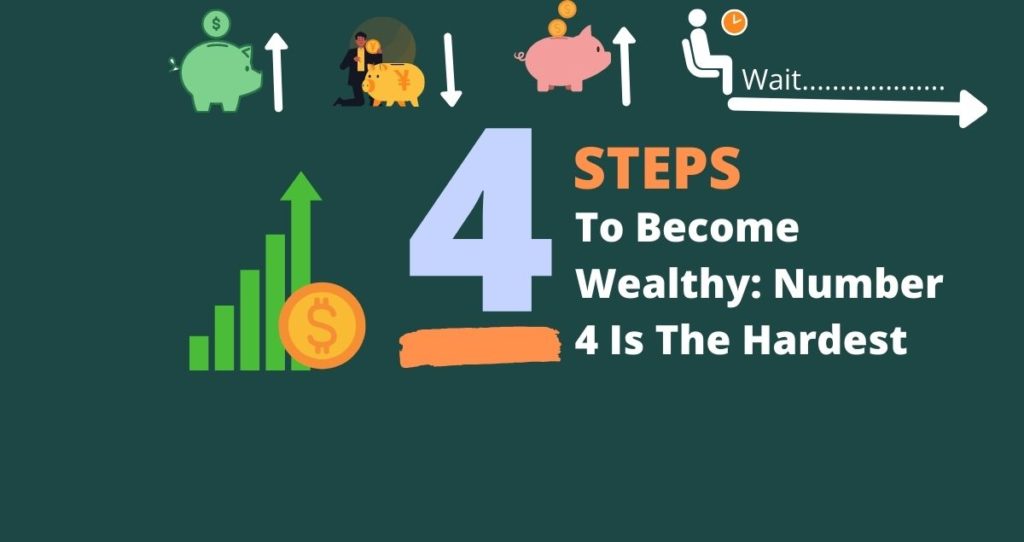If you dream of building wealth or simply reaching financial independence, you might need to start investing as it is the easiest way to get rich besides having your own business. Before you start investing, however, there are things you need to do to protect your investments and ensure a high return on investment(ROI).
Establishing financial goals, knowing your risk tolerance, learning the basics, and creating an emergency fund are some of the most important things to do before investing.
If you are new to investing, check out this list of the top 8 must-do things before you start investing your hard-earned money.
1. Identify your financial goals and priorities
Before you start investing, establish your financial goals and why you are investing. This is because the investment you pick and your time horizon must align with your goals to minimize losses and maximize your return on investment(ROI). Are you saving for retirement, a down payment on a house, a 529 child’s education savings plan, or another significant expense?
Knowing what you’re investing for will help guide your investment choices and risk tolerance. Typically, your risk tolerance shapes your portfolio type and the types of investments you hold. For example, if you are 55 and want to preserve capital, creating an income portfolio might serve you well. On the other hand, if you are 30, creating a growth portfolio will be a great option as you can afford to take more risk.
You might also like: 9 best retirement goals for retirees in 2024
2. Understand your risk tolerance
The term “risk tolerance” is one of the biggest factors every investor needs to worry about. Even experienced investors worry about risk tolerance as much as they worry about return on investment. Without factoring risk tolerance into your investment strategies, you can take on more risk than you can handle or leave opportunities on the table.
What does risk tolerance mean? Simply put, risk tolerance measures how much risk you are willing to take. Every investment comes with some form of risk and risks differ from one investment to another. For example, certificates of deposit(CDs) carry less risk than individual stocks before they are ensured by FDIC up to $250,000 and are not volatile.
Not all investments are created equal, and some come with a higher degree of risk than others. Before you start investing, assess your risk tolerance. Would you be able to sleep at night knowing your investments could lose value, or would you prefer slow and steady growth?
5 types of portfolios you can create based on your risk of tolerance
- Income portfolio. This portfolio is made of 80% fixed income such as bonds, money management accounts, loans, and 20% equities.
- Conservative/defensive portfolio. This type of portfolio is made of 60% fixed-income assets and 40% equities.
- Moderate portfolio. This portfolio has 40% fixed-income assets and 60 equities.
- Growth portfolio. The growth portfolio is made of 80% equities and 20% fixed-income assets.
- Aggressive portfolio. An aggressive portfolio has 100% equities.
Before you start investing, evaluate your risk tolerance as it helps you create the right portfolio that aligns with your financial goals.
3. Learn about different types of investments
One of the most important steps that many investing newbies underestimate is learning the basics of investing. A wise man once said, “Playing a game without learning its rules is the first step to losing it”.
Investing is like a game where those who know the rules of the game win. How do you win the investing game? You succeed at investing by learning how investing works and familiarizing yourself with the different investments available.
The more you know about different types of investments, the better you can make informed decisions. Understand the basics of stocks, bonds, mutual funds, real estate, and other investment options. Each type of investment comes with its own set of risks and rewards.
You might also like:
- Real Estate Terms: Real estate’s most used terms
- 53 Personal Finance Terms You Need to Know
- How to invest money: An investment guide
4. Establish an emergency fund
Before investing money, you must establish an emergency fund. I do agree that you can invest and save for an emergency fund at the same time. But, if you are new to investing, it is wise to build up your emergency account first. The goal of an emergency fund is to cover unexpected expenses such as a medical bill, car repair, roof repair, or the loss of a job.
The lack of an emergency fund exposes you to major financial risks, should something bad happen. You can mitigate these financial risks by establishing an emergency before investing.
You should save three to six months’ worth of living expenses in an emergency fund. This provides a financial safety net and allows you to invest with more confidence and less worry.
If you have a low income and living paycheck to paycheck, use a savings challenge to help you save more money.
Related posts:
- Should you invest your emergency fund for better returns?
- 4 ways to save for emergency fund
- 21 best money-saving challenges to try in 2024
5. Pay off high-interest debts
According to me, debt is the biggest killer of all financial dreams. While you can use debt to build wealth, consumer debt is not good for you or your loved ones. Debt also gets in your way when you want to invest money. For example, if you have $50,000 in credit card debt, the interest charges you pay on this debt will be more than you can earn if you invest $50k.
So, always pay off high-interest debt first before you start investing. Let me show you why paying off debt before investing is the best financial decision.
The average credit card APR is about 24% while the average return on investment is about 10% based on the historical return of the S&P 500. If you choose to invest $50,000 instead of paying off your credit card debt, you will make about $5,000 while paying $12,000 in credit card interest charges. In other words, you will be losing money.
To recap, if you have high-interest debts, such as credit cards, it’s wise to pay them off before investing. This is because the return on your investments could be wiped out by the high interest you will pay on debt.
You might also like:
- How to use the debt avalanche method to pay off debt?
- How to use the debt snowball method to pay off debt?
6. Develop an investment plan and stick to it
Investing money is not like throwing money in random stocks and hoping to reap a huge return. To make money from your investments, you need an investment strategy and stick to it. Research shows that 90% of people lose money in the stock market and the lack of strategy is one of the biggest contributing factors to this high failure rate.
To not be like the 90% of people who lose money from their investments, develop an investment plan and stick to it.
An investment plan is a set of rules that guide you through your investment strategies and choices. These rules help you pick the right investment based on your risk tolerance and financial goals. By sticking to your plan, you will avoid making impulsive decisions or chasing ‘hot tips’. Some of the investing principles you should stick to include but are not limited to investing regularly, diversifying your portfolio, and periodically rebalancing to keep things on track.
You might also like: 15 Ways to Become Rich Without Investing in Real Estate
7. Seek professional advice
If you are new to investing, seek professional help before investing. While you can DIY investing, your biggest struggle will be staying disciplined long enough during market downturns. The hard truth is that everyone is an investing expert during a bull market. When markets are down 30-50%, you see the real investors and speculators.
You need a financial advisor to help you design an investment plan that matches your financial goals while shielding you from extreme market risks. The advisor will also help you make the right decisions when everyone is panicking and selling at a huge loss.
Related: Choose a financial advisor in 9 Steps
8. Track your net worth
One of the biggest investing strategies that works for me is tracking your net worth. You need to know how you are doing financially. Are you making progress or are you losing money? Tracking your net worth is essential as it shows you what is working and what is not.
Knowing that you are doing great motivates you to keep going, invest more, and stick to your plan.
How much should I invest?
Knowing how much to invest is one of the biggest questions millions of investing newbies struggle with. The question sounds childish but it is one of the hardest to answer because what works for one person does not work for another. It is a personal thing. How much you invest depends on your current financial situation and financial goals.
For example, a person with no debt and a $100,000 income can easily invest $20,000 without losing sleep. However, someone making only $50,000/year might not afford to invest $20,000.
So, how much should you invest?
What I like about investing is that there is no right or wrong amount you can invest. You can invest as little as $10 or as much as $100,000 or more. To know how much you can safely invest, evaluate your financial goals, and current financial situations, and build an emergency fund for a safety net.
The best amount you can invest is the amount you can let go without losing sleep. Your risk tolerance, financial goals, timeline, and current income, determine how much you can invest.
When I started investing, I used the 50-30-20 budget rule. This rule says that 50% of your take-home must go to essential obligations such as rent, food, and utilities, 30% should be allocated to your wants, and 20% to your savings and debt payment. If you don’t have debt, that 20% will be invested or saved for future growth. You can also cut back on your wants to invest more.
If you have a retirement plan with your work, you can start investing in your 401(k) plan and contribute at least up to your employer match. You can also open an IRA to take advantage of retirement tax incentives.
But, if you cannot afford to invest a lot of money, start with what you can afford. For example, invest $50/month if you can afford that. What matters is that you start and regularly invest. You can always increase your investment amount over time.
You might also like: How to save for retirement without a 401(k)?
Is investing $1,000 a month enough?
Investing $1,000 per month can be a huge challenge or not enough depending on your salary and financial situation. For example, if you make $40,000 investing $1,000 could be difficult as it translates to putting away $12,000 of your after-tax earnings every year. But, if you make $100,000, investing $1,000 can be like a piece of cake.
Additionally, if you have too much high-interest debt, investing $1,000 could be unaffordable even if you have a high income.
The point is that investing $1,000 could be enough or too much depending on your financial situation. What is good enough is what you can afford to invest without causing you financial stress or losing sleep.
How much of my salary should I invest?
By default, you should invest between 10% to 25% of your salary. This range is only a guideline as how much you can afford to invest depends on many factors such as current debt balance, income, and other financial obligations. If you cannot afford to invest 10% of your income, it does not mean you cannot invest. Start with what you can afford even if it is $5 to take advantage of compound interest. Time in the market beats timing the market.
More investing tips
15 ways to become rich without investing in real estate
How to make money with CDs: Make $200/mo on CDs
5 different types of portfolios: Which portfolio is right for you?








